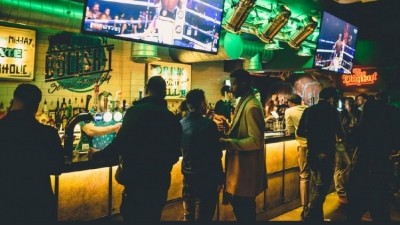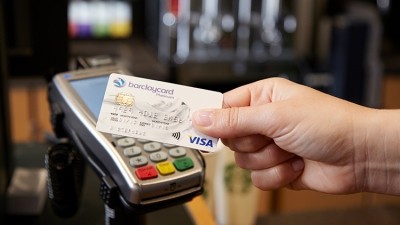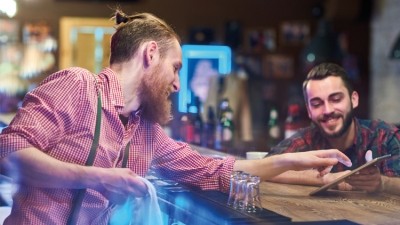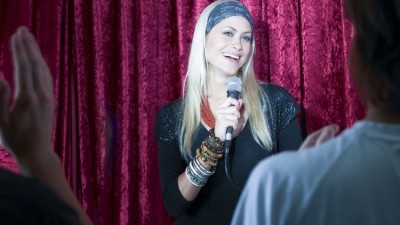In association with Barclaycard
Cash is dead: Long live the card
Businesses left, right and centre are ditching cash payments for many reasons, with the main being that consumers these days rarely carry notes or coins.
The card society, however, has its perks; it’s quicker and easier for customers, but also the dreaded cashing up at the end of a shift, with the threat of an unbalanced till, is no longer a headache.
Some may miss the jingle of cash, the ruffling of bank notes and clumsy fumbling to find that penny to make the right change, while others are likely to welcome the simplicity of a tap.
Cashless society
Those reluctant to believe a cashless society is fast approaching (remember cheques?) should quickly think again.
Statistics from UK Finance, for instance, show that 2017 was a pivotal year for payments, with card transactions outweighing cash for the first time at a score of £13.2bn for card versus £13.1bn for cash.
The same organisation tells The Morning Advertiser (MA) it’s unlikely this will reverse, with a spokesperson saying: “We expect the trend to continue, as customers and businesses increasingly opt for the convenience of paying in a way that suits them.”
‘Sans cash’ is no fad and is being driven further by newer payment methods like contactless cards, as well as through mobile phone technology.
Indeed, a recent poll of MA readers showed that more than a third of operators champion cashless payments as time saving and hailed its ability to cut queues and increase customer satisfaction.
Even newer systems, such as Barclaycard’s recently-trialled Dine & Dash technology, could do away with the need for customers to ask for the bill altogether.
Central to the system is an electronic ‘totem’, which customers tap with their phone to check in, before ordering their meal, eating it and then leaving without the need to ask for a bill, since their payment details are already registered.
With all this in mind, as a sector, we must have our electronic payment systems sussed or be prepared for trouble.
And those who believe they have little to improve on may need to think again, because the majority of operators still need much help to ensure their cashless payment systems are prepared for the challenge of ever-increasing use.
A smooth experience
The basics, the things that operators may feel they had sorted long ago, such as Wi-Fi and hardware, are the main areas in need of focus to cater for the future of card-carrying consumers.
“Wi-Fi is critical to any integrated stock, cash management and drinks/food ordering systems,” says Brendan Padfield, owner of the Unruly Pig, in Bromeswell, Suffolk.
“We’re in a right state when the Wi-Fi crashes. Going back to manual card payments when the system is down is very painful and time consuming.”
Wi-Fi’s actual reach can also be an irritation for many operators, including Padfield, who says his current system only extends halfway along the award-winning gastropub’s garden. “There’s no doubt a Wi-Fi system that doesn’t reach all corners of the site does detract from a smooth customer-focused experience.”
Cards are 90% of payments in the Unruly Pig, which means any inefficiencies in the system are very noticeable.
Having enough terminals to take to tables is essential to avoid customers queuing awkwardly at the bar or, much worse, waiting at their tables for long periods before being able to pay.
Seafood Pub Company managing director Joycelyn Neave, who runs a growing 11-strong pub chain in the north of England, is the first to ensure her sites are fully functioning when it comes to Wi-Fi.
The venues are all out in the sticks, often with no phone signal or 4G – not even 2G or GPRS – so Neave must ensure they all have optimum Wi-Fi capabilities for customers to have working mobile phones, as well as to make payments.
The real hassle, however, is when a large party wants individualised bills split according to consumption. If you get a party of 15 going through each and every thing they ate or drank, the process is hugely time consuming and can be a right pain
– Brendan Padfield, the Unruly Pig
“At almost all of our locations, mobile signal is bad,” she explains. “Getting it right is not just for people to use the internet, it’s also about people being able to make contact on things like FaceTime.”
Seafood Pub Company ensures Wi-Fi is consistent throughout its sites by adding multiple access points and in new builds and renovated sites, tests are carried out to ensure ample reach.
In gardens, where the Wi-Fi won’t reach, Neave provides her pubs with 3G card payment terminals, which usually do the trick. However, there are occasions when customers may need to come inside to make their payment, which is handled with a polite explanation.
HR and training manager Mark Vaughan at national pub, bar and hotel chain Beds & Bars relies on a technology company to ensure Wi-Fi at its sites are up for the job.
In some of the company’s venues, for instance, Wi-Fi has to reach up to five floors and must work for up to 500 people, he says. When the basics don’t work, however, Beds & Bars will install Wi-Fi extenders.
The simplicities
For payment terminals, Beds & Bars looks for hardware that’s not cumbersome and that doesn’t print “huge receipts” either, often with the ability to avoid paper copies altogether.
But the tech and the infrastructure, to some, can be the easy part of the process because, once it’s in, it’s usually there for good and needs minimal maintenance and few upgrades. Difficulties can, however, occur when it comes to staff and their ability to handle the payments.
On the face of it, it sounds easy. Someone orders food or drink and, when it’s consumed, they pay for it. Yet, there are nuances that should be considered to avoid awkward situations or lasting bitter impressions from customers who may end up feeling embarrassed or annoyed.
The simplicities of being able to split the bill; pointing out how gratuity can be added; how the elderly have been catered for; or how those with young children have been considered at the point of payment are, in fact, all part of the last impression about the venue.
Their meal may have been perfect, delivered by attentive and courteous staff, but a fumbling front-of-house team, unable to take payment in a simple way, could mar all of that work.
Splits the bills
For Padfield, with most of the pub’s payments made by card, he feels the Unruly Pig is in a good position. “Our till system splits bills whatever the size of the party and creates individual bills,” he says. “One button divides it equally and according to the size of the party.
“The real hassle, however, is when a large party wants individualised bills split according to consumption. If you get a party of 15 going through each and every thing they ate or drank, the process is hugely time consuming and can be a right pain.”
Padfield’s solution is to hand the party the bill to work out themselves, “otherwise the process gets lengthy”.
Thinking about the elderly or families with young children, who might have difficulties moving long distances from their tables to payment points, it is essential staff make things as easy as possible by seating them where it’s certain a smooth transaction can be made.
Avoiding the bugbear of waiting too long for the bill is also central to the best customer experience.
As part of the customer service journey, our customers will have had an epic time. The customers will most likely be chatting to our team as they take their payment
– Mark Vaughan, Beds & Bars
Research by Barclaycard showed that 25% of consumers would consider walking out of a venue without paying the bill if the wait was too long.
More worryingly, 65% claimed they wouldn’t return to an outlet if there was a long wait to pay the bill.
Nick Kerigan, managing director of Future Payments at Barclaycard, says: “Eating out is something we all look forward to, yet our research shows waiting to pay is an increasing frustration.”
Technology such as the payment provider’s Dine & Dash system, he adds, could be integral to getting the last part of a meal right.
“Building on our experience in ‘invisible payments’, we wanted to create an innovative solution that removes barriers to enjoying the meal, while also helping restaurants deliver great service to keep diners coming back.”
Turn away or face them?
But, for those with more traditional payment systems, when the time comes for the terminal to be handed to the customer for their personal identification number, the big question is, should staff members turn away or face them? For Vaughan, staff never turn away.
“As part of the customer service journey, our customers will have had an epic time,” he says. “The customers will most likely be chatting to our team as they take their payment.”
For Neave, it’s about simply training staff to point out to the customer to “follow the instructions on the terminal”, before passing it over and then politely waiting.
“There’s no need to make a point of turning your back, but don’t stare at them and the card machine,” she adds.
When it comes to upselling at this point, the operators’ opinions vary. Padfield, simply, doesn’t believe in it. “Heavens. No. Never should they upsell at this point,” he says.
However, Vaughan is more relaxed, allowing the staff to make their own minds up by relying on their training and judging the situation for themselves.
Yes, the mighty tap of a bankcard has become a vital part of everyone’s daily routine; however, there are many intricacies to be considered if we are to take full advantage of the process in business.







